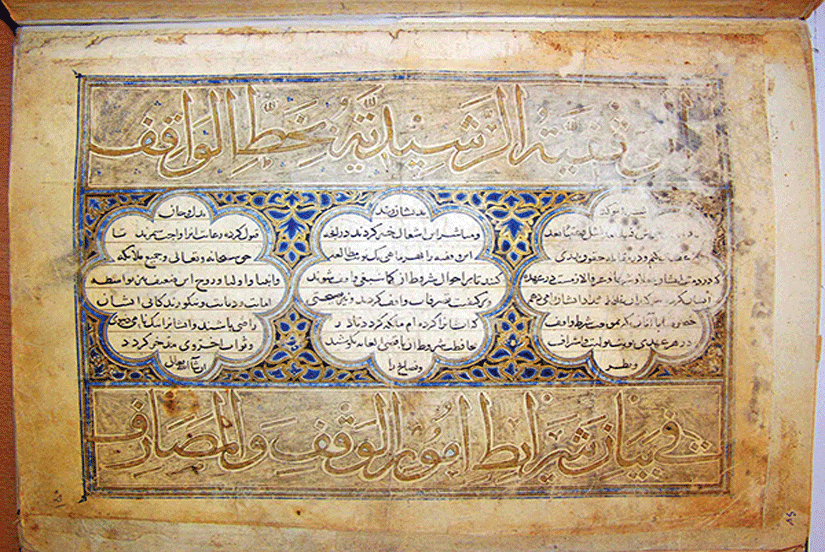
The Deed for Endowment: Rab’-e Rashidi
Rab’-e Rashidi, at the foot of the Mount Sorkhab in Tabriz, is built by the order of Rashid-al-Din (718- 648 AH), chief minister of Oljeitu, late in thirteenth centuries. Built in a residential area, Rab’-e Rashidi includes various buildings such as mosques, various schools, hospitals (Dar al-Shafa), pharmacy, libraries, inns, bathhouses, houses, orphanage, mills, dyeing workshops, weaving , Paper making, Mints , various shops (markets), gardens and separate neighborhoods with beautiful homes for the accommodation of various social classes. Rashid-al-Din brought a number of people from other cities and towns including scrivener, scholars, Quranic scholars and physicians.

This manuscript of which there is only one copy in the whole world was written by Rashid al-Din Fazlullah Hamadani in Tabriz. During his ministry, Rab’-e Rashidi established a large complex in the suburbs of Tabriz dedicated to scientific and research activities. To build and operate this large scientific complex, a large amount of property was dedicated to the collection of letters written by Rab’-e Rashidi himself, and in this letter, we find out what a large scientific complex was operating in Tabriz at that time.

Some Topics in the Book
- Geographical names and names of Yazd populations and different regions, especially Azerbaijan from the seventh and eighth centuries, which have found or have disappeared in the course of time.
- Information on the historical geography of Tabriz and Yazd.
- Names and names of important religious and religious figures, and information contained in this dedication letter about various people, such as their great masters
- Recognize important educational, scientific, religious, medical and charitable establishments at that time.
- How the endowment works and how the endowment is administered.
- Aquatics terms in Tabriz and names of marshes in Tabriz and Yazd and various names for water and land scales.
- How water is transported to Tabriz and the amount of water.
- Knowledge of agriculture and how to protect cereals from pests.
- Information on architecture, shaping of buildings and terms related to different parts of mansions.
- Various names related to different land divisions such as Soltani, Divaniyyah, Atabaki, Sanghari, Sahabi and ...
- Recognize the titles and titles of different social groups.
- Signs of Zoroastrian facilities in Yazd at that time.
- Tips on financial status, weights and amounts, individual wages and many administrative and billing terms.
A lot of information about the social life of the people of that period. Celebrations, religious and mourning events such as the whimsical nightclub that was officially celebrated for the first night of burial in Tabriz, information on foods, names of breads and cooks, as well as how to cook some foods, day-to-day health issues, and understanding different herbal remedies could be read in the book.

Where is the book now?
This edition is currently kept in the Tabriz Central Library, and it is listed in Iran UNESCO Memory of the World.
Related Tags:
We love to hear your comments